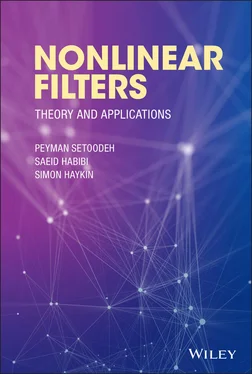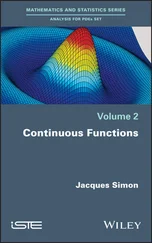Simon Haykin - Nonlinear Filters
Здесь есть возможность читать онлайн «Simon Haykin - Nonlinear Filters» — ознакомительный отрывок электронной книги совершенно бесплатно, а после прочтения отрывка купить полную версию. В некоторых случаях можно слушать аудио, скачать через торрент в формате fb2 и присутствует краткое содержание. Жанр: unrecognised, на английском языке. Описание произведения, (предисловие) а так же отзывы посетителей доступны на портале библиотеки ЛибКат.
- Название:Nonlinear Filters
- Автор:
- Жанр:
- Год:неизвестен
- ISBN:нет данных
- Рейтинг книги:5 / 5. Голосов: 1
-
Избранное:Добавить в избранное
- Отзывы:
-
Ваша оценка:
Nonlinear Filters: краткое содержание, описание и аннотация
Предлагаем к чтению аннотацию, описание, краткое содержание или предисловие (зависит от того, что написал сам автор книги «Nonlinear Filters»). Если вы не нашли необходимую информацию о книге — напишите в комментариях, мы постараемся отыскать её.
Discover the utility of using deep learning and (deep) reinforcement learning in deriving filtering algorithms with this insightful and powerful new resource Nonlinear Filters: Theory and Applications
Nonlinear Filters
Nonlinear Filters: Theory and Applications



 in terms of the available quantities such that the observer estimation errors
in terms of the available quantities such that the observer estimation errors  and
and  are steered to zero in a finite number of steps. To design the discrete‐time sliding‐mode observer, the sliding manifold is defined as
are steered to zero in a finite number of steps. To design the discrete‐time sliding‐mode observer, the sliding manifold is defined as  . Hence, by putting
. Hence, by putting  in ( 3.29), the equivalent control input,
in ( 3.29), the equivalent control input,  , can be found as [37, 38]:
, can be found as [37, 38]:
 , sliding mode occurs at the next step, and the governing dynamics of
, sliding mode occurs at the next step, and the governing dynamics of  will be described by:
will be described by:
 through designing the observer gain matrix,
through designing the observer gain matrix,  . In order to place the eigenvalues of
. In order to place the eigenvalues of  at the desired locations, the pair
at the desired locations, the pair  must be observable. This condition is satisfied if the pair
must be observable. This condition is satisfied if the pair  is observable. This leads to a sliding‐mode realization of the standard reduced order asymptotic observer [37].
is observable. This leads to a sliding‐mode realization of the standard reduced order asymptotic observer [37]. is unknown. Therefore, the following recursive equation is obtained from ( 3.29) to compute
is unknown. Therefore, the following recursive equation is obtained from ( 3.29) to compute  :
:

 is obtained from ( 3.32). Given
is obtained from ( 3.32). Given  , the discrete‐time sliding‐mode observer provides the state estimate as [37]:
, the discrete‐time sliding‐mode observer provides the state estimate as [37]:


 ,
,  , and
, and  . It is assumed that the matrix
. It is assumed that the matrix  has full column rank, which can be achieved using an appropriate transformation. Response of the system ( 3.35) and ( 3.36) over
has full column rank, which can be achieved using an appropriate transformation. Response of the system ( 3.35) and ( 3.36) over  time steps is given by [35]:
time steps is given by [35]:
 is the observability matrix for the pair
is the observability matrix for the pair  , and
, and  is the invertibility matrix for the tuple
is the invertibility matrix for the tuple  . The matrices
. The matrices  and
and  can also be expressed as [35]:
can also be expressed as [35]:










